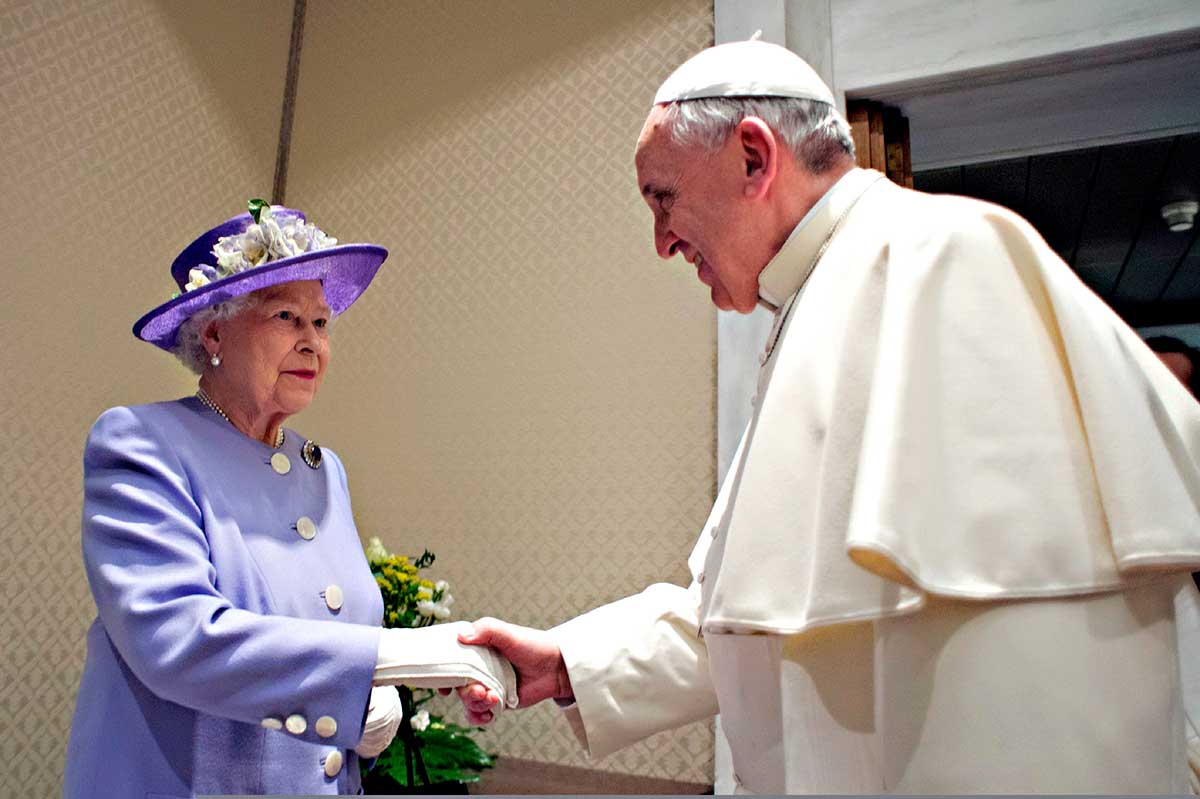Queen, Church and Change

Pope Francis greets Britain’s Queen Elizabeth II during a meeting at the Vatican in this April 3, 2014, file photo. The pope sent well-wishes to the queen on the occasion of her Platinum Jubilee celebration marking 70 years on the throne. (CNS photo/Vatican Media via Reuters)
Whether you are a fan of monarchies or not, it was impossible to ignore the impact on the world of the death in September of Queen Elizabeth II. This was in part because of the extraordinary 70 years of her reign, and also the breadth of the people and the countries whose lives she touched.
One may have an impassioned debate about the person of the monarch and about the value of a hereditary head of state, but this is not the place to do so. However, I would like to use her death to explore something of her contribution to Christianity and of the role of her particular denomination.
Her funeral, watched by billions of people worldwide, was very firmly in the Anglican tradition. Many people will have marvelled not just at the pomp and circumstance of British royal ceremony but also at the quiet dignity, elegant language, prayerfulness and transcendent music of the religious aspects of the service. The Church of England are masters at liturgy.
The location, Westminster Abbey, is where she was married 75 years ago, where she took her vows as monarch in 1953 (mirroring the Old Testament religious ritual of anointing kings), and where, in about a year from now, her son, Charles III, will be crowned. It is an abbey, not a cathedral, because since its creation possibly in the 7th century and then for about 900 years, it was a monastery with monks and an abbot.
The English Reformation under Henry VIII involved the mass destruction of religious houses (“the dissolution of the monasteries”). While all monastic communities were scattered, some buildings, like Westminster Abbey, were spared and an important aspect of monastic life was retained: the daily singing of the office of hours.
The reason why the singing at the Queen’s funeral was so extraordinary is because at the abbey, and in every cathedral and many, many churches in the Church of England, the ancient tradition of singing the psalms at set times during the day has been honoured, week in and week out, for centuries. Thus, matins and vespers are very much part of the public liturgical life of Anglicans. On the other hand, this very Catholic medieval tradition has been all but lost to the vast majority of Catholics, and observed only as a muttered private practice by most priests.
I make this point because to understand Anglicanism, we need to bear in mind that they are a Church that sees itself as both catholic and reformed: drawing on the best from both movements in Church history; recognising the value — to take the cue from the title of a famous Anglican hymnal — of both “Ancient and Modern”. The reason why British monarchs use the title “Defender of the Faith” is that Pope Leo X granted it to Henry VIII for defending Catholic doctrine against the reformers — before the king’s break with Rome.
Reform takes courage
Reform always takes courage — it is tempting to just carry on doing things the way they have always been done. It took great courage on the part of the bishops at Vatican II to recognise that the Catholic Church needed reform. And it also takes wisdom. As the Council Fathers learnt, and as we have had to struggle with as a Church in the last 60 years, judging what to change and what to keep is a constant challenge. Too much reform and we lose our roots; too little and our branches become lifeless and impotent.
I see the Anglican Church as having performed a great service for the wider Christian community through its willingness to test the edges and to try new things, recognising that sometimes this will be hard. When Archbishop Denis Hurley, on behalf of all English-speaking bishops worldwide, started the process through ICEL of creating a Catholic liturgy in English, he had the great benefit of being able to draw on a 450-year “experiment” by the Church of England to make Scripture and prayer accessible to English-speakers in their own language.
If or when Catholics return to the ancient tradition whereby most priests were married, we will be able to learn from the experience of denominations like the Anglicans, where parishes have coped comfortably with a clergy who are married and have children. In fact, the hundreds of Anglican priests who have become Catholic priests in the last 20 years, and have kept their wives, means perhaps that the “pilot” is already underway.
If or when Catholics start contemplating the priestly role of women in the Church, again there will be lessons we can learn from the Anglicans. Should our Church ever be willing to actually admit the faithful contribution of LGBT+ people to our parishes, our families and our religious life, we will be able to draw on the difficult but necessary conversations that have been happening in the Anglican Communion.
Queen met popes
Queen Elizabeth II herself had been part of that process of change. While remaining a faithful Anglican, she had also witnessed huge changes in practice over her reign, not least the fact that her son can have a divorcée as his queen. When she took her oaths as monarch, she promised “to the utmost of her power, to maintain in the United Kingdom the Protestant Reformed Religion established by law”.
And yet, she was the first British monarch since the Reformation to meet a pope — visiting five of them in the Vatican and welcoming two of them to the UK. She enjoyed warm relations with a number of Catholic bishops — most especially with the late Basil Hume OSB of Westminster. She invited Catholic clergy to preach at royal churches and she herself attended a service at a Catholic cathedral.
The most striking change in her lifetime has been the removal of the prohibition on British monarchs (or their spouses) being Catholic: in 2015, the 1701 Act of Settlement was finally reversed. This, coupled with her personal commitment to ecumenism, has enabled the queen to play an exemplary role in fostering reconciliation in the north of Ireland. This was demonstrated in the respect she showed to the Irish president, the Gaelic language, the 1916 freedom fighters, and the current Nationalist politicians (and the reciprocal respect recently shown her by Republican Ireland). There are still differences of political opinion, but her actions show that they cannot be legitimised by invoking religious difference.
All of this is at the grand scale and perhaps should be expected of a head of state overseeing change in the modern age. But there is one way in which Elizabeth II never changed: and that is the deep and public devotion she had to her faith. In modern Britain, religion is barely mentioned or, if it is, as a problem to be solved or an awkward private eccentricity. The name of Jesus is hardly heard in the UK outside of a church even during “the festive season”; but in her annual broadcast (to the country and the Commonwealth, the queen publicly placed Christ at the centre of Christmas. Her funeral rites again made it clear that her faith in Christ and in the resurrection were not just public pieties.
I draw three lessons from Queen Elizabeth’s life which, I think, can inspire us all: her dedication to service (which for her was absolutely rooted in her Christian vocation); her demonstration that you can be faithful to your own religious tradition and still be open to others; and that — in the Anglican way — change and continuity are not enemies but two disciples walking side by side with Christ.
- Compassion and Consolation - September 3, 2025
- The Church in the Modern World - July 14, 2025
- Dr Raymond Perrier: My 150th Southern Cross Column - June 9, 2025







